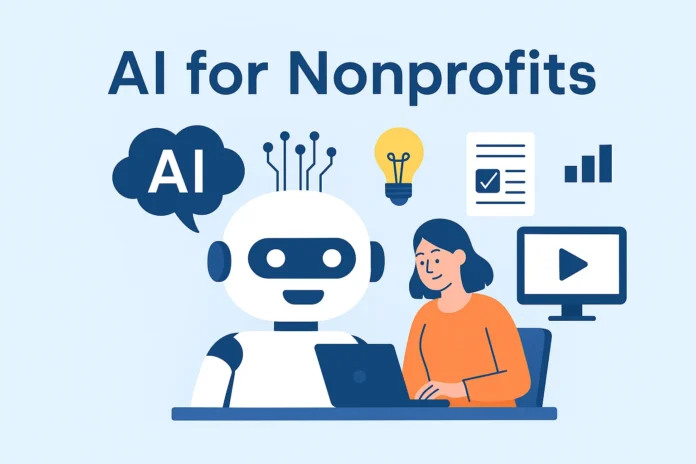Generative AI (GenAI) tools like ChatGPT, DALL·E, and other large language or image models have opened exciting new possibilities for nonprofits. Many organizations are already leveraging these tools to:
- Draft donor appeals and grant reports
- Create outreach visuals and social media posts
- Summarize long documents or meeting notes
- Translate content or adapt messaging for different audiences
These uses offer valuable time savings, especially for small teams with big missions. But while GenAI is a great starting point, it’s not the final destination.
The next phase—and arguably the more transformative one—is Operational AI: using AI to improve workflows, data quality, predictions, accessibility, fundraising, and day-to-day decision-making in ways that are secure, ethical, and mission-specific. That’s the focus of this article.
1. From GenAI to Operational AI
Content generation is helpful—but what about automating follow-ups, predicting donor churn, or flagging incomplete records before audits? This is where AI becomes embedded in your operations and expands your organization’s capacity.
Operational AI isn’t just about creativity; it’s about consistency, compliance, accessibility, and capability. For example, AI can:
- Make Programs More Accessible: Automatically translate materials, generate adaptive content for people with disabilities, and personalize outreach for underserved communities.
- Improve Fundraising: Analyze giving patterns, predict donor churn, and personalize communications to increase engagement and retention.
2. The Hidden Risk: How AI Models Are Trained
As AI adoption spreads, some vendors build larger training models by pooling data from multiple nonprofits. While they may claim this data excludes personally identifiable information (PII), the practice still carries serious risks:
- Nonprofits may not have explicit consent to share even anonymized data
- Combining data across organizations creates security and compliance concerns
- Outputs may reflect biases or patterns not relevant to your specific community or mission
Your nonprofit’s data is not generic—it represents your unique programs, communities, and outcomes. That’s why it’s critical that AI models are:
- Trained specifically on your nonprofit’s data
- Isolated from other organizations’ data
- Secure, transparent, and fully within your control
This approach ensures your AI tools are not just more relevant—they’re safer and more compliant, especially in sectors like healthcare, education, housing, or immigration where data sensitivity is high.
3. Practical Use Cases: AI that Works for Nonprofits
Improved Data Quality & Intake
AI can clean, tag, and standardize incoming data—from forms, emails, call logs, or surveys—ensuring accuracy and reducing manual work.
Quick Insights & Reporting
AI can help nonprofits quickly generate reports, dashboards, and data summaries that reveal what’s working and what needs attention. Whether it’s tracking donor engagement, program outcomes, or operational KPIs, AI-powered reporting tools give you a clearer picture—faster.
Workflow Automations
Use AI to automate repetitive but essential tasks:
- Sending reminders or thank-you emails
- Notifying staff of status changes
- Updating records across systems
AI-Powered Case Management
Agentic AI can act like a co-pilot, offering dynamic task lists, identifying urgent cases, and surfacing recommendations to help frontline staff stay focused on impact.
Public-Facing Tools: Accessibility, SEO, and Chat Widgets
AI-powered website widgets can help users find information, complete applications, or understand services—while simultaneously optimizing content for search visibility and accessibility (e.g., real-time translation, screen-reader compatibility).
Fundraising Optimization
AI can help you:
- Predict donor churn and identify high-value prospects
- Personalize donor communications and optimize donation asks
- Automate stewardship and re-engagement campaigns
At LiveImpact, we’ve seen firsthand how these applications can transform nonprofit operations, making programs more accessible and fundraising more effective.
4. A Smarter, Safer Approach to AI
Privacy and Data Ethics
AI in the nonprofit sector must be held to the highest ethical standards. Always ask:
- Who owns the data being used to train this model?
- Is consent explicit and traceable?
- Can I fully audit and control how my data is being used?
Nonprofits are entrusted with sensitive data—and AI strategies must respect that trust.
Bring in the Experts
AI is evolving rapidly. Every nonprofit should consult experts who understand both the technology and the nonprofit context. The right advisors can help:
- Define a practical, ethical AI roadmap
- Evaluate vendor claims
- Align AI tools with organizational goals
- Build internal confidence and capacity
Engaging AI experts is not a luxury—it’s a necessary step to ensure you’re making sound, sustainable choices.
Start Small: Pilot Programs and Capacity Building
Begin with small, focused AI pilots to manage risk and build staff confidence. Invest in staff training and change management to ensure successful adoption and long-term impact.
Affordability without Compromise
With open-source tools, nonprofit-specific platforms, and modular architectures, AI no longer has to be prohibitively expensive. Start small, demonstrate ROI, and scale responsibly—without sacrificing privacy or relevance.
5. Vendor Evaluation Checklist
Before selecting an AI vendor, consider these questions:
- Where and how is this model trained?
- Is your data used to train models for others?
- Is there a clear audit trail?
- Who reviews outputs for bias or errors?
- Does the system support your mission’s unique needs?
- Can you control and audit data usage?
6. Co-Intelligence, Not Replacement
AI is not about replacing your team. It’s about augmenting it.
The most effective use of AI in nonprofits is co-intelligent: humans and machines working together, with the machine handling mundane tasks and surfacing insights—and humans applying empathy, ethics, and judgment.
7. Risks and Red Flags
Before you adopt any AI tool, ask tough questions and set clear policies on usage, permissions, and oversight. AI can amplify mistakes as easily as it amplifies impact. Keep humans in the loop and maintain strong governance.
Conclusion
AI holds real promise for nonprofits—not just to save time, but to strengthen decision-making, improve service delivery, make programs more accessible, and scale impact. But realizing that promise requires moving beyond content generation into tools built specifically for your mission, your data, and your communities.
By staying focused on privacy, purpose, and people, nonprofits can harness AI not just efficiently—but ethically. Start small, learn quickly, and build a future where technology and mission go hand in hand.
At LiveImpact, we’re committed to helping nonprofits navigate this journey, drawing on deep experience in building secure, mission-aligned AI solutions. If you’re ready to explore what’s possible, we’re here to help.
🚀 Free AI Consultation for Nonprofits
We’re offering a free consultation to help nonprofits understand today’s AI landscape and define a smart, tailored AI Strategy. Click here to book your free consultation.
🎉 We’re hosting a free live demo of Live Impact on Nonprofit Library!
You’ll get to see how the platform works and how it can help your nonprofit thrive.

